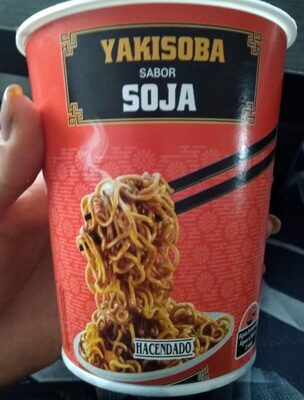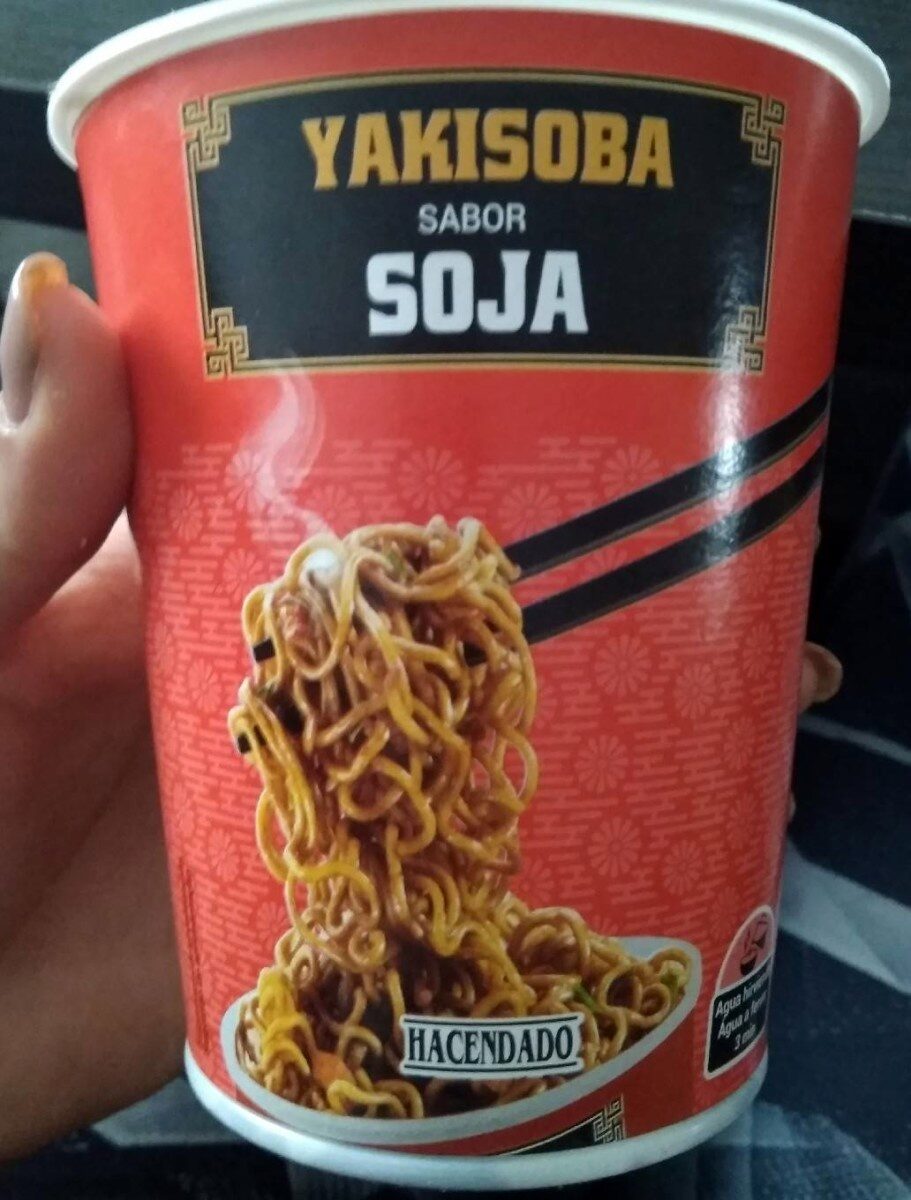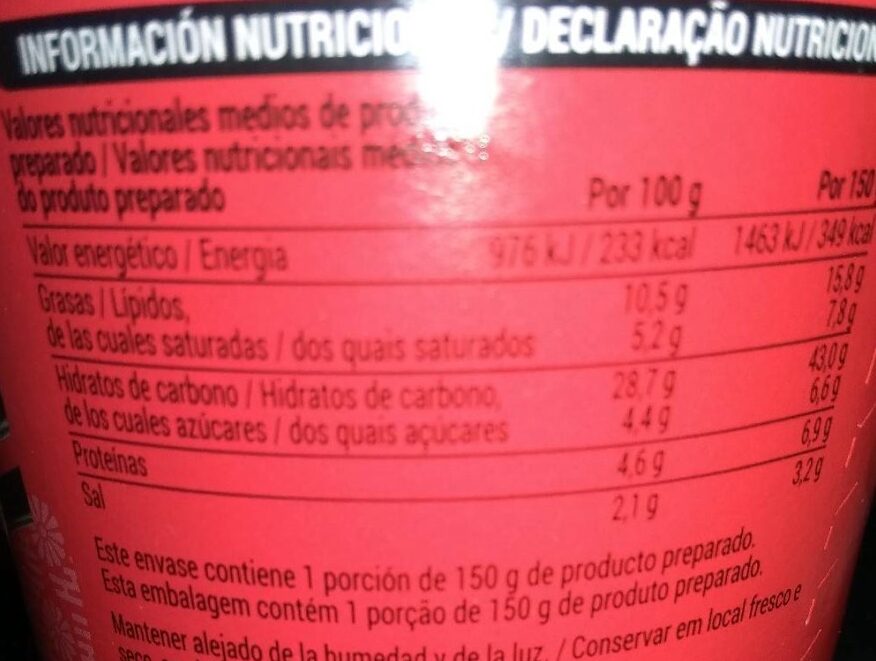Help us make food transparency the norm!
As a non-profit organization, we depend on your donations to continue informing consumers around the world about what they eat.
The food revolution starts with you!
Yakisoba sabor soja - Hacendado - 80 g
Yakisoba sabor soja - Hacendado - 80 g
This product page is not complete. You can help to complete it by editing it and adding more data from the photos we have, or by taking more photos using the app for Android or iPhone/iPad. Thank you!
×
Barra-kodea: 8480000087270 (EAN / EAN-13)
Izen arrunta: Preparado alimenticio instantáneo de fideos de trigo con salsa Yakisoba a base de soja
Kopurua: 80 g
Ontziratzea: es:Green dot
Markak: Hacendado
Kategoriak: en:Plant-based foods and beverages, en:Plant-based foods, en:Cereals and potatoes, en:Cereals and their products, en:Meals, en:Dried products, Pasta, en:Dried products to be rehydrated, en:Noodles, en:Dried meals, en:Instant noodles
Etiketak, ziurtagiriak, sariak:
en:Contains gluten, en:Green Dot
Dendak: Mercadona
Saltzen diren herrialdeak: Espainia
Matching with your preferences
Health
Osagaiak
-
39 ingredients
Gaztelania: Fideos 80,0% (harina de trigo, aceite de palma, sal, potenciador del sabor (E621), agentes de tratamiento de la harina (E500, E451), antioxidante (E306), corrector de acidez (ácido cítrico)), sazonador líquido 18,1% (azúcar, agua, aceite de colza, salsa de soja 8,8% (agua, habas de soja, sal, trigo), potenciadores del sabor (E621, E635), colorante (E150c), dextrosa, melaza, vinagre, sal, especias, proteína vegetal hidrolizada, tomate en polvo, corrector de acidez (ácido cítrico), aromas), zanahoria, cebolleta.Alergenoak: en:Gluten, en:SoybeansAztarnak: en:Celery, en:Crustaceans, en:Fish, en:Milk, en:Molluscs, en:Mustard, en:Sesame seeds
Food processing
-
Ultra processed foods
Elements that indicate the product is in the 4 - Ultra prozesatutako elikagaiak eta edariak group:
- Gehigarria: E150c
- Gehigarria: E451
- Gehigarria: E621
- Gehigarria: E635
- Osagaia: Colour
- Osagaia: Dextrose
- Osagaia: Flavour enhancer
- Osagaia: Flavouring
- Osagaia: Glukosa
Food products are classified into 4 groups according to their degree of processing:
- Prozesatu gabeko edo ahalik eta gutxien prozesatutako elikagaiak
- Sukaldaritzako osagaiak prozesatu
- Prozesatutako jakiak
- Ultra processed foods
The determination of the group is based on the category of the product and on the ingredients it contains.
Gehigarriak
-
E330 - Azido zitriko
Citric acid: Citric acid is a weak organic acid that has the chemical formula C6H8O7. It occurs naturally in citrus fruits. In biochemistry, it is an intermediate in the citric acid cycle, which occurs in the metabolism of all aerobic organisms. More than a million tons of citric acid are manufactured every year. It is used widely as an acidifier, as a flavoring and chelating agent.A citrate is a derivative of citric acid; that is, the salts, esters, and the polyatomic anion found in solution. An example of the former, a salt is trisodium citrate; an ester is triethyl citrate. When part of a salt, the formula of the citrate ion is written as C6H5O3−7 or C3H5O-COO-3−3.Source: Wikipedia (Ingeles)
-
E451
Sodium triphosphate: Sodium triphosphate -STP-, also sodium tripolyphosphate -STPP-, or tripolyphosphate -TPP-,- is an inorganic compound with formula Na5P3O10. It is the sodium salt of the polyphosphate penta-anion, which is the conjugate base of triphosphoric acid. It is produced on a large scale as a component of many domestic and industrial products, especially detergents. Environmental problems associated with eutrophication are attributed to its widespread use.Source: Wikipedia (Ingeles)
-
E500
Sodium carbonate: Sodium carbonate, Na2CO3, -also known as washing soda, soda ash and soda crystals, and in the monohydrate form as crystal carbonate- is the water-soluble sodium salt of carbonic acid. It most commonly occurs as a crystalline decahydrate, which readily effloresces to form a white powder, the monohydrate. Pure sodium carbonate is a white, odorless powder that is hygroscopic -absorbs moisture from the air-. It has a strongly alkaline taste, and forms a moderately basic solution in water. Sodium carbonate is well known domestically for its everyday use as a water softener. Historically it was extracted from the ashes of plants growing in sodium-rich soils, such as vegetation from the Middle East, kelp from Scotland and seaweed from Spain. Because the ashes of these sodium-rich plants were noticeably different from ashes of timber -used to create potash-, they became known as "soda ash". It is synthetically produced in large quantities from salt -sodium chloride- and limestone by a method known as the Solvay process. The manufacture of glass is one of the most important uses of sodium carbonate. Sodium carbonate acts as a flux for silica, lowering the melting point of the mixture to something achievable without special materials. This "soda glass" is mildly water-soluble, so some calcium carbonate is added to the melt mixture to make the glass produced insoluble. This type of glass is known as soda lime glass: "soda" for the sodium carbonate and "lime" for the calcium carbonate. Soda lime glass has been the most common form of glass for centuries. Sodium carbonate is also used as a relatively strong base in various settings. For example, it is used as a pH regulator to maintain stable alkaline conditions necessary for the action of the majority of photographic film developing agents. It acts as an alkali because when dissolved in water, it dissociates into the weak acid: carbonic acid and the strong alkali: sodium hydroxide. This gives sodium carbonate in solution the ability to attack metals such as aluminium with the release of hydrogen gas.It is a common additive in swimming pools used to raise the pH which can be lowered by chlorine tablets and other additives which contain acids. In cooking, it is sometimes used in place of sodium hydroxide for lyeing, especially with German pretzels and lye rolls. These dishes are treated with a solution of an alkaline substance to change the pH of the surface of the food and improve browning. In taxidermy, sodium carbonate added to boiling water will remove flesh from the bones of animal carcasses for trophy mounting or educational display. In chemistry, it is often used as an electrolyte. Electrolytes are usually salt-based, and sodium carbonate acts as a very good conductor in the process of electrolysis. In addition, unlike chloride ions, which form chlorine gas, carbonate ions are not corrosive to the anodes. It is also used as a primary standard for acid-base titrations because it is solid and air-stable, making it easy to weigh accurately.Source: Wikipedia (Ingeles)
-
E621
Monosodium glutamate: Monosodium glutamate -MSG, also known as sodium glutamate- is the sodium salt of glutamic acid, one of the most abundant naturally occurring non-essential amino acids. Glutamic acid is found naturally in tomatoes, grapes, cheese, mushrooms and other foods.MSG is used in the food industry as a flavor enhancer with an umami taste that intensifies the meaty, savory flavor of food, as naturally occurring glutamate does in foods such as stews and meat soups. It was first prepared in 1908 by Japanese biochemist Kikunae Ikeda, who was trying to isolate and duplicate the savory taste of kombu, an edible seaweed used as a base for many Japanese soups. MSG as a flavor enhancer balances, blends, and rounds the perception of other tastes.The U.S. Food and Drug Administration has given MSG its generally recognized as safe -GRAS- designation. A popular belief is that large doses of MSG can cause headaches and other feelings of discomfort, known as "Chinese restaurant syndrome," but double-blind tests fail to find evidence of such a reaction. The European Union classifies it as a food additive permitted in certain foods and subject to quantitative limits. MSG has the HS code 29224220 and the E number E621.Source: Wikipedia (Ingeles)
Ingredients analysis
-
en:Palm oil
Ingredients that contain palm oil: Palmondo olio
-
en:Maybe vegan
Ingredients that may not be vegan: E635, en:Flavouring
-
en:Maybe vegetarian
Ingredients that may not be vegetarian: E635, en:Flavouring
-
Details of the analysis of the ingredients
es: Fideos 80% (harina de _trigo_, aceite de palma, sal, potenciador del sabor (e621), agentes de tratamiento de la harina (e500, e451), antioxidante (e306), corrector de acidez (ácido cítrico)), sazonador 18.1% (azúcar, agua, aceite de colza, salsa de _soja_ 8.8% (agua, habas de _soja_, sal, _trigo_), potenciadores del sabor (e621, e635), colorante (e150c), dextrosa, melaza, vinagre, sal, especias, proteína vegetal hidrolizada, tomate, corrector de acidez (ácido cítrico), aromas), zanahoria, cebolleta- Fideos -> en:noodle - vegan: maybe - vegetarian: maybe - percent: 80
- harina de _trigo_ -> en:wheat-flour - vegan: yes - vegetarian: yes - ciqual_proxy_food_code: 9410
- aceite de palma -> en:palm-oil - vegan: yes - vegetarian: yes - from_palm_oil: yes - ciqual_food_code: 16129
- sal -> en:salt - vegan: yes - vegetarian: yes - ciqual_food_code: 11058
- potenciador del sabor -> en:flavour-enhancer
- e621 -> en:e621 - vegan: yes - vegetarian: yes
- agentes de tratamiento de la harina -> en:flour-treatment-agent
- e500 -> en:e500 - vegan: yes - vegetarian: yes
- e451 -> en:e451 - vegan: yes - vegetarian: yes
- antioxidante -> en:antioxidant
- e306 -> en:e306 - vegan: yes - vegetarian: yes
- corrector de acidez -> en:acidity-regulator
- ácido cítrico -> en:e330 - vegan: yes - vegetarian: yes
- sazonador -> en:coating - vegan: maybe - vegetarian: maybe - percent: 18.1
- azúcar -> en:sugar - vegan: yes - vegetarian: yes - ciqual_proxy_food_code: 31016
- agua -> en:water - vegan: yes - vegetarian: yes - ciqual_food_code: 18066
- aceite de colza -> en:colza-oil - vegan: yes - vegetarian: yes - from_palm_oil: no - ciqual_food_code: 17130
- salsa de _soja_ -> en:soy-sauce - vegan: maybe - vegetarian: maybe - ciqual_food_code: 11104 - percent: 8.8
- agua -> en:water - vegan: yes - vegetarian: yes - ciqual_food_code: 18066
- habas de _soja_ -> en:soya-bean - vegan: yes - vegetarian: yes - ciqual_food_code: 20901
- sal -> en:salt - vegan: yes - vegetarian: yes - ciqual_food_code: 11058
- _trigo_ -> en:wheat - vegan: yes - vegetarian: yes - ciqual_proxy_food_code: 9410
- potenciadores del sabor -> en:flavour-enhancer
- e621 -> en:e621 - vegan: yes - vegetarian: yes
- e635 -> en:e635 - vegan: maybe - vegetarian: maybe
- colorante -> en:colour
- e150c -> en:e150a - vegan: yes - vegetarian: yes
- dextrosa -> en:dextrose - vegan: yes - vegetarian: yes - ciqual_proxy_food_code: 31016
- melaza -> en:molasses - vegan: yes - vegetarian: yes - ciqual_proxy_food_code: 31016
- vinagre -> en:vinegar - vegan: yes - vegetarian: yes - ciqual_food_code: 11018
- sal -> en:salt - vegan: yes - vegetarian: yes - ciqual_food_code: 11058
- especias -> en:spice - vegan: yes - vegetarian: yes
- proteína vegetal hidrolizada -> en:hydrolysed-vegetable-protein - vegan: yes - vegetarian: yes
- tomate -> en:tomato - vegan: yes - vegetarian: yes - ciqual_food_code: 20047
- corrector de acidez -> en:acidity-regulator
- ácido cítrico -> en:e330 - vegan: yes - vegetarian: yes
- aromas -> en:flavouring - vegan: maybe - vegetarian: maybe
- zanahoria -> en:carrot - vegan: yes - vegetarian: yes - ciqual_food_code: 20009
- cebolleta -> en:welsh-onion - vegan: yes - vegetarian: yes - ciqual_food_code: 20034
- Fideos -> en:noodle - vegan: maybe - vegetarian: maybe - percent: 80
Elikadura
-
Poor nutritional quality
⚠ ️Warning: the amounts of fiber and of fruits, vegetables and nuts are not specified, their possible positive contribution to the grade could not be taken into account.This product is not considered a beverage for the calculation of the Nutri-Score.
Positive points: 0
- Proteinak: 2 / 5 (balioa: 4.6, rounded value: 4.6)
- Fiber: 0 / 5 (balioa: 0, rounded value: 0)
- Fruits, vegetables, nuts, and colza/walnut/olive oils: 0 / 5 (balioa: 0, rounded value: 0)
Negative points: 16
- Energia: 2 / 10 (balioa: 976, rounded value: 976)
- Azukreak: 0 / 10 (balioa: 4.4, rounded value: 4.4)
- Gantz saturatua: 5 / 10 (balioa: 5.2, rounded value: 5.2)
- Sodioa: 9 / 10 (balioa: 840, rounded value: 840)
The points for proteins are not counted because the negative points are greater or equal to 11.
Nutritional score: (16 - 0)
Nutri-Score:
-
Nutrient levels
-
Koipe in moderate quantity (10.5%)
What you need to know- A high consumption of fat, especially saturated fats, can raise cholesterol, which increases the risk of heart diseases.
Recommendation: Limit the consumption of fat and saturated fat- Choose products with lower fat and saturated fat content.
-
Gantz-azido ase in high quantity (5.2%)
What you need to know- A high consumption of fat, especially saturated fats, can raise cholesterol, which increases the risk of heart diseases.
Recommendation: Limit the consumption of fat and saturated fat- Choose products with lower fat and saturated fat content.
-
Azukre in low quantity (4.4%)
What you need to know- A high consumption of sugar can cause weight gain and tooth decay. It also augments the risk of type 2 diabetes and cardio-vascular diseases.
Recommendation: Limit the consumption of sugar and sugary drinks- Sugary drinks (such as sodas, fruit beverages, and fruit juices and nectars) should be limited as much as possible (no more than 1 glass a day).
- Choose products with lower sugar content and reduce the consumption of products with added sugars.
-
Gatz arrunt in high quantity (2.1%)
What you need to know- A high consumption of salt (or sodium) can cause raised blood pressure, which can increase the risk of heart disease and stroke.
- Many people who have high blood pressure do not know it, as there are often no symptoms.
- Most people consume too much salt (on average 9 to 12 grams per day), around twice the recommended maximum level of intake.
Recommendation: Limit the consumption of salt and salted food- Reduce the quantity of salt used when cooking, and don't salt again at the table.
- Limit the consumption of salty snacks and choose products with lower salt content.
-
-
Nutrition facts
Nutrition facts Prepared
for 100 g / 100 mlPrepared
per serving (150 g)Compared to: en:Instant noodles Energia 976 kj
(233 kcal)1.460 kj
(350 kcal)Koipe 10,5 g 15,8 g Gantz-azido ase 5,2 g 7,8 g Carbohydrates 28,7 g 43 g Azukre 4,4 g 6,6 g Fiber ? ? Proteina 4,6 g 6,9 g Gatz arrunt 2,1 g 3,15 g Fruits‚ vegetables‚ nuts and rapeseed‚ walnut and olive oils (estimate from ingredients list analysis) ? ?
Ingurumena
-
Eco-Score C - Moderate environmental impact
The Eco-Score is an experimental score that summarizes the environmental impacts of food products.→ The Eco-Score was initially developped for France and it is being extended to other European countries. The Eco-Score formula is subject to change as it is regularly improved to make it more precise and better suited to each country.Life cycle analysis
-
Average impact of products of the same category: A (Score: 82/100)
Kategoria: Asian noodles, flavoured, dehydrated
Kategoria: Asian noodles, flavoured, dehydrated
- PEF environmental score: 0.26 (the lower the score, the lower the impact)
- including impact on climate change: 1.67 kg CO2 eq/kg of product
Stage Impact Agriculture
65.5 %Processing
20.6 %Ontziratzea
8.7 %Transportation
3.5 %Distribution
1.8 %Consumption
0.0 %
Bonuses and maluses
-
Missing origins of ingredients information
Malus: -5
⚠ ️ The origins of the ingredients of this product are not indicated.
If they are indicated on the packaging, you can modify the product sheet and add them.
If you are the manufacturer of this product, you can send us the information with our free platform for producers.
-
Ingredients that threatens species
Malus: -10
Contains palm oil
Tropical forests in Asia, Africa and Latin America are destroyed to create and expand oil palm tree plantations. The deforestation contributes to climate change, and it endangers species such as the orangutan, the pigmy elephant and the Sumatran rhino.
-
Missing packaging information for this product
Malus: -15
⚠ ️ The information about the packaging of this product is not filled in.⚠ ️ For a more precise calculation of the Eco-Score, you can modify the product page and add them.
If you are the manufacturer of this product, you can send us the information with our free platform for producers.
Eco-Score for this product
-
Impact for this product: C (Score: 52/100)
Produktua: Yakisoba sabor soja - Hacendado - 80 g
Life cycle analysis score: 82
Sum of bonuses and maluses: -30
Final score: 52/100
-
Carbon footprint
-
Equal to driving 0.9 km in a petrol car
167 g CO² per 100g of product
The carbon emission figure comes from ADEME's Agribalyse database, for the category: Asian noodles, flavoured, dehydrated (Source: ADEME Agribalyse Database)
Stage Impact Agriculture
61.0 %Processing
14.9 %Ontziratzea
16.3 %Transportation
6.8 %Distribution
1.0 %Consumption
0.0 %
Ontziratzea
-
Missing packaging information for this product
⚠ ️ The information about the packaging of this product is not filled in.Take a photo of the recycling information Take a photo of the recycling information
Transportation
-
Origins of ingredients
Missing origins of ingredients information
⚠ ️ The origins of the ingredients of this product are not indicated.
If they are indicated on the packaging, you can modify the product sheet and add them.
If you are the manufacturer of this product, you can send us the information with our free platform for producers.Add the origins of ingredients for this product Add the origins of ingredients for this product
Threatened species
-
Contains palm oil
Drives deforestation and threatens species such as the orangutan
Tropical forests in Asia, Africa and Latin America are destroyed to create and expand oil palm tree plantations. The deforestation contributes to climate change, and it endangers species such as the orangutan, the pigmy elephant and the Sumatran rhino.
Report a problem
-
Incomplete or incorrect information?
Category, labels, ingredients, allergens, nutritional information, photos etc.
If the information does not match the information on the packaging, please complete or correct it. Open Food Facts is a collaborative database, and every contribution is useful for all.
Datuen iturria
Product added on by kiliweb
Last edit of product page on by victor-hermes.
Produktuaren orria -gatik editatua alia, elcoco, openfoodfacts-contributors, roboto-app, yourself, yuka.ZktzUE1hQlJvdGRTeDlvazRqck44UElyKzVMMFlHT3NlOEEzSVE9PQ.











